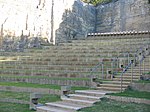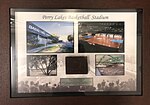Perry Lakes Reserve

The Perry Lakes Reserve is a nature reserve located approximately 7 kilometres (4.3 mi) west of Perth, the capital city of Western Australia, in the suburb of Floreat. Within the 80-hectare (200-acre) reserve are two lakes, East Lake and West Lake, comprising approximately 12.6 hectares (31 acres).In its current form, the reserve dates from 1962 when the area was landscaped in association with the construction of Perry Lakes Stadium and associated sporting tracks and facilities for the 1962 British Empire and Commonwealth Games. The Australian Scout Jamboree has been held in the parkland twice, during the summers of 1979/80 and 1994/95. The sporting complex was demolished in 2011 to make way for housing development.
Excerpt from the Wikipedia article Perry Lakes Reserve (License: CC BY-SA 3.0, Authors, Images).Perry Lakes Reserve
Perry Lakes Drive, Town Of Cambridge
Geographical coordinates (GPS) Address Nearby Places Show on map
Geographical coordinates (GPS)
| Latitude | Longitude |
|---|---|
| N -31.943781 ° | E 115.780462 ° |
Address
Perry Lakes Drive
Perry Lakes Drive
6015 Town Of Cambridge, City Beach
Western Australia, Australia
Open on Google Maps








